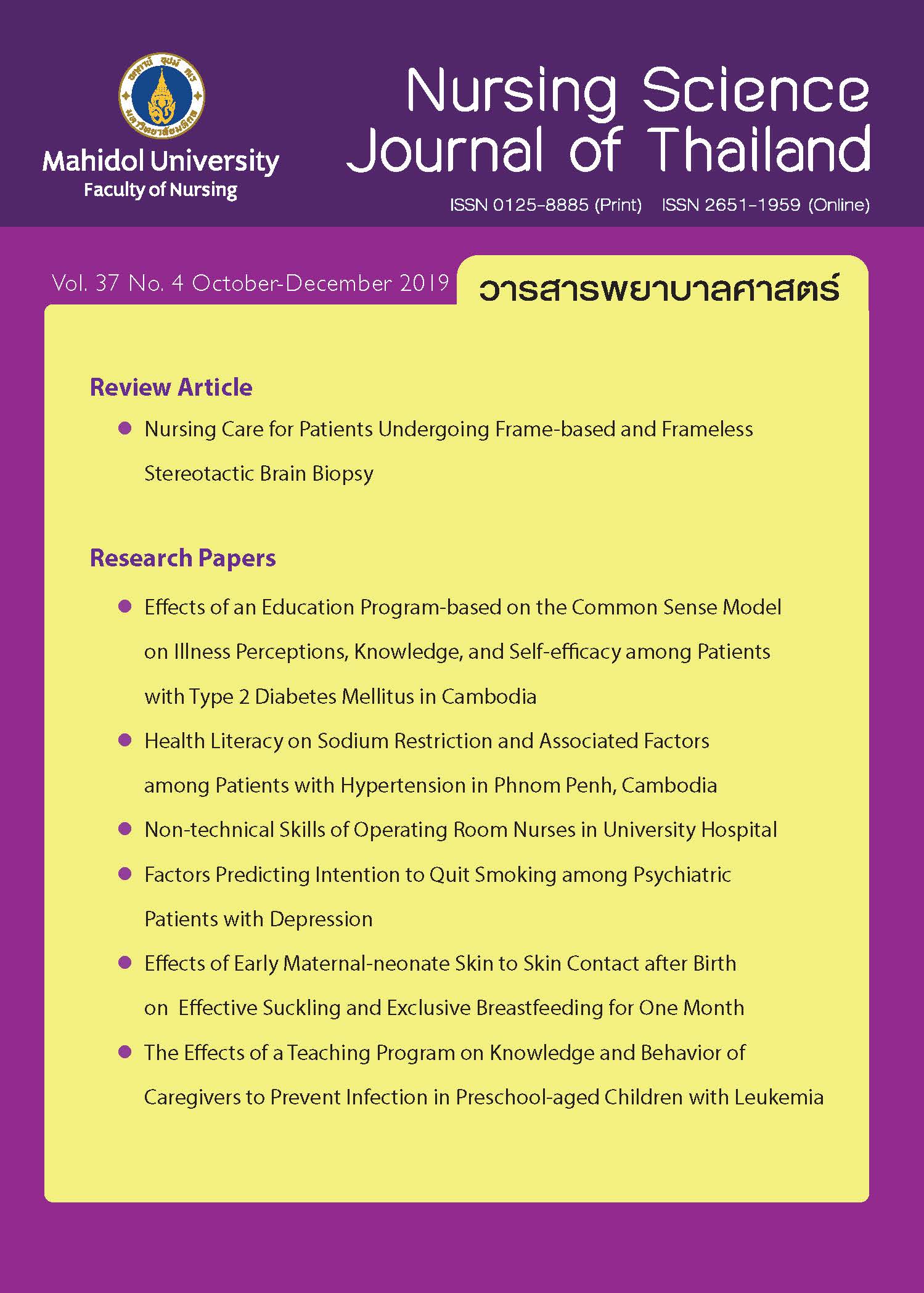Non-technical Skills of Operating Room Nurses in University Hospital
Main Article Content
Abstract
Purpose: To examine the behavior of non-technical skills of scrub nurses during intra -operative phase, and the relationship between age, work experience and type of surgery of scrub nurses.
Design: Descriptive correlation study.
Methods: Non-technical skills of ninety-nine scrub nurses in operating rooms at University hospital in Thailand were observed using SPLINT System consisting of 3 subscales (situation awareness, communication and teamwork, task management). Inter-rater reliability using Cohen’s kappa was .99. Data were analyzed by using descriptive statistics, Pearson product moment correlation and one-way ANOVA.
Main findings: The sample had non-technical skills at a standard level for each subscale; 1) task management, = 3.21, SD = .46) 2) situation awareness,
= 3.15, SD = .56 and 3) communication and teamwork,
= 3.05, SD = .53 respectively. Age and work experience were found to be positively correlated with non-technical skills at significance level .05. (r = .263, p < .01; r = .386, p < .01, respectively). Surgery with high procedure complexity needs more overall non-technical skills and task management domain than other type of surgery (F = 3.609, p < .05 and F = 5.787, p < .01, respectively)
Conclusion and recommendations: Non-technical skills are important skills scrub nurses in operating rooms must require; thus, there is a need to maintain standard non-technical skills for the scrub nurses in the setting. A workshop or training to enhance these nurses to achieve such skills beyond the standard level is suggested in order to improve patient safety in the operating rooms and being a role model for others to follow.
Article Details
Copyright Notice: Nursing Science Journal of Thailand has exclusive rights to publish and distribute the manuscript and all contents therein. Without the journal’s permission, the dissemination of the manuscript in another journal or online, and the reproduction of the manuscript for non-educational purpose are prohibited.

Disclaimer: The opinion expressed and figures provided in this journal, NSJT, are the sole responsibility of the authors. The editorial board bears no responsibility in this regard.
References
2. The Association of periOperative Registered Nurses (AORN). Guidelines for perioperative practice 2018. 1st ed. Denver, CO: AORN, Inc.; 2018. 994 p.
3. Serino MF. Quality and patient safety teams in the perioperative setting. AORN J. 2015;102(6):617-28. doi: 10.1016/j.aorn.2015.10.006.
4. Kirk LM. Professionalism in medicine: definitions and considerations for teaching. Proc (Bayl Univ Med Cent). 2007;20(1):13-6. doi: 10.1080/08998280.2007.11928225.
5. Onler E, Yildiz T, Bahar S. Evaluation of the communication skills of operating room staff. J Interprof Educ Pract. 2018;10:44-6. doi: 10.1016/j.xjep.2017.11.004.
6. Mitchell L, Flin R. Non-technical skills of the operating theatre scrub nurse: literature review. J Adv Nurs. 2008;63(1):15-24. doi: 10.1111/j.1365-2648.2008.04695.x.
7. Reader T, Flin R, Lauche K, Cuthbertson BH. Non-technical skills in the intensive care unit. Br J Anaesth. 006;96(5):551-9. doi: 10.1093/bja/ael067.
8. Bell L. Using OR patient classification for staffing assignment. AORN J. 2015;101(6):639-45. doi: 10.1016/j.aorn.2015.03.003.
9. Fletcher G, Flin R, McGeorge P, Glavin R, Maran N, Patey R. Rating non-technical skills: developing a behavioural marker system for use in anaesthesia. Cogn Technol Work. 2004;6(3):165-71. doi: 10.1007/s10111-004-0158-y.
10. Yule S, Flin R, Paterson-Brown S, Maran N, Rowley D. Development of a rating system for surgeons’ non-technical skills. Med Educ. 2006;40(11):1098-104. doi: 10.1111/j.1365-2929.2006.02610.x.
11. Mitchell L, Flin R, Yule S, Mitchell J, Coutts K, Youngson G. Thinking ahead of the surgeon. An interview study to identify scrub nurses’ non-technical skills. Int J Nurs Stud. 2011;48(7):818-28. doi: 10.1016/j.ijnurstu.2010.11.005.
12. Mitchell L, Flin R, Yule S, Mitchell J, Coutts K, Youngson G. Development of a behavioural marker system for scrub practitioners’ non-technical skill (SPLINTS system). J Eval Clin Pract. 2013;19(2):317-23. doi: 10.1111/j.1365-2753.2012.01825.x.
13. Mitchell L, Flin R, Yule S, Mitchell J, Coutts K, Youngson G. Evaluation of Scrub practitioner’s List of Intraoperative Non-Technical Skill (SPLINTS) system. Int J Nurs Stud. 2012;49(2):201-11. doi: 10.1016/j.ijnurstu.2011.08.012.
14. Joint Commission. Sentinel event statistics data - root causes by event type (2004-2015) [Internet]. Oak Brook, Illinois: Joint Commission Resources; 2016 [cited 2016 May 31]. Available from: https://www.jointcommission.org/assets/1/18/Root_Causes_by_Event_Type_2004-2015.pdf.
15. Fletcher G, Flin R, McGeorge P, Glavin R, Maran N, Patey R. Anaesthetists’ Non-Technical Skills (ANTS): evaluation of a behavioural marker system. Br J Anaesth. 2003;90(5):580-8. doi: 10.1093/bja/aeg112.
16. Cohen J. Statistical power analysis for the behavioral sciences. 2nd ed. Mahwah, NJ: Lawrence Erlbaum Associates; 1988. 527 p.
17. Waltz CF, Strickland OL, Lenz ER. Measurement in nursing and health research. 4th ed. New York: Springer Publishing; 2010. 477 p.
18. Lingard L, Espin S, Whyte S, Regehr G, Baker GR, Reznick R, et al. Communication failures in the operating room: an observational classification of recurrent types and effects. Qual Saf Health Care. 2004;13(5):330-4. doi: 10.1136/qhc.13.5.330.
19. Sevdalis N, Healey AN, Vincent CA. Distracting communications in the operating theatre. J Eval Clin Pract. 2007;13(3):390-4. doi: 10.1111/j.1365-2753.2006.00712.x.
20. Lingard L, Espin S, Rubin B, Whyte S, Colmenares M, Baker GR, et al. Getting teams to talk: development and pilot implementation of a checklist to promote interprofessional communication in the OR. Qual Saf Health Care. 2005;14(5):340-6. doi: 10.1136/qshc.2004.012377.
21. Lark ME, Kirkpatrick K, Chung KC. Patient safety movement: history and future directions. J Hand Surg Am. 2018;43(2):174-8. doi: 10.1016/j.jhsa.2017.11.006.
22. Caney BT, West P, Neily J, Bagian C. Difference in nurse and surgeon perceptions of teamwork: implications for use of a briefing checklist in the OR. AORN J. 2010;91(6):722-9. doi: 10.1016/j.aorn.2009.11.066.
23. Carvalho PA, Gottems LB, Pires MR. de Oliveria ML. Safety culture in the operating room of a public hospital in the perception of healthcare professionals. Rev Lat Am Enfermagem. 2015;23(6):1041-8. doi: 10.1590/0104-1169.0669.2647.
24. Phitayakorn R, Minehart RD, Hemingway MW, Pian-Smith MCM, Petrusa E. The relationship between intraoperative teamwork and management skill in patient care. Surgery. 2015:158(5):1434-40. doi: 10.1007/s00464-007-9346-1.
25. Siu J, Maran N, Paterson-Brown S. Observation of behavioral markers of non-technical skills in the operating room and their relationship to intra-operative incidents. Surgeon. 2016;14(3):119-28. doi: 10.1016/j.surge.2014.06.005.


